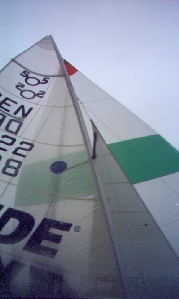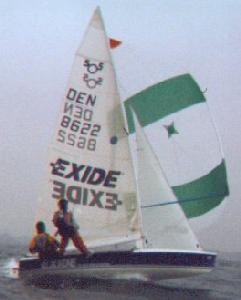Danish Larger Spinnaker Tests
Second Test
Yesterday we had the second Danish test with a larger spinnaker.
-
Spin: Standard BM One Design (17 m2) with 90 cm cloth added in the middle (leech 5.90 m) approx. 20.5 m2.
-
Rig: Standard Superspar M2, the only change is the spinnaker halyard is raised 85 cm above the normal position.
-
Wind: 7-12 knots
-
Sea: below 1 ft.
-
Temp. minus 2 degrees Celsius.
-
Helm: 75 kg
-
Crew: 78 kg
-
5 boats practicing - short up & down courses
Tom Bojland
Danish 505 Class Association
Third Test
Yesterday we made the third Danish test with a larger spinnaker.
-
Spinnaker: New design with following size
-
Luff 6.00 (5.90)
-
Bottom 4.50 (3.96)
-
Half height 3.96 (3.46)
-
24 m2 (21 m2)
-
Figures in ( ) are from the previous two tests, for comparison purposes.
4 boats practicing - short up & down courses. First experience: It�s BIIIIIG!!!!!...... |
Still no structural problems with the mast despite the fact that the spinnaker was even bigger, we made some photos from the boat and they will be available on the web in a few days.
The spinnaker was very easy to control on the downwind, but it was definitely not easy to sail a close reach with it in these conditions.
It can be a bit fuller and wider on half height, but else, its about to look interesting on a up & down course.
We will be back with further information.
Tom Bojland
Danish 505 Class
Association
Fourth Test
Yesterday we made the fourth danish test with a larger spinneker.
Spin.: New design with following size
-
Luff 6.00 (5.90)
-
Bottom 4.50 (3.96)
-
Half height 3.96 (3.46)
-
24 m2 (21 m2)
Figures in ( ) is the old one from first two test�s.
Rig: Standard Superspar M2, only change is spinnaker halyard raised 85 cm above normal
position.
-
Wind: 4-8 knots
-
Sea: below 1 ft.
-
Temp. minus 1 degrees celcius.
-
Helm: 75 kg
-
Crew: 95 kg
6 boats practicing - short up & down courses.
In such light conditions there isn't a big difference between a standard spinnaker and a big one, only a small difference in speed because because of the light wind.
Tom Bojland
Danish 505 Class Association
Fifth Test
Hi all!
Now Team Polse have tried the large spinnaker as well. Here is my first impression of the monster.
Spinnaker:
-
Luff 6.00
-
Bottom 4.50
-
Half height 3.96
-
24 m2
Rig: Standard Superspar M2, only change is spin. halyard raised 85 cm above normal position.
-
Wind: 10-15 knots
-
Sea: 2 feet.
-
Temp. Who gives a sh..
-
Helm: 73 kg
-
Crew: 95 kg
There where three boats on the water. We sailed an up/down course. in the first couple of races we sailed the same compass bearings as the two other boats. The difference was that while they where sitting on the tank not really able to plane we where blasting away with Morten on the wire. Later the wind picked up a bit and we sailed the compass bearings we felt where the optimal to bring us as fast as possible to the bottommark. So did our opponents. On a course with a length of 1/2 nautical mile we where able to gain 150 m.
The boathandling where if possible easier than with an ordinary spinnaker due to the extra speed and smaller gybing angle. To get the spinnaker in and out of the shute gave no problems except for two extra meters of halyard to pull.
The rig did not seem to struggle to carry the extra amount of sail surface.
In my opinion the size of the spinnaker could easily be increased with .3m on the luff and .5 m on the bottom and half height measurements which would make the 505 a true high performance dinghy.
Jan Saugmann
Denmark
Discussion
Hi Tom,
Thanks very much for your reports on your spinnaker trials.
It is really interesting. I believe the end result will show that if we proceed with a
larger spinnaker we will also have to revise the course we sail. Which makes one wonder if
there is any overall benefit. However I'll reserve my opinion until significant trials
have been performed and the results evaluated.
Cheers,
Pip
Pip Pearson
President International 505 Class Yacht Racing Association
Hi Pip!
I fully agree with you about that.
If we want a bigger spinnaker we have to change our courses, the spinnaker we all use now is of course optimal for the 55 degree course.
What I see as a possibility that we haven�t thought about before, is the fact that a lightweight crew today can have serious problems on a windy day on most of the legs (except for the dead run). With an up-and-down course they probably will win on the downwind what they loose on the beat. So actually we makes it easier for a light crew to be competitive in strong winds (at least I think so!!!) which I personally think is quite interresting with a crew of 77 kg *grin*.
The boat goes faster which is in my point of view more fun. The tactics are new (and difficult) but the main point, it has to be fun, cheap, and must not obsolete any boats if we are going to do any changes.
Cheers
Tom
PS: I am sure that Paul E. [Ed. Paul Elvstrom] is wondering whats going on, we are practicing outside his place every Sunday with 5-6 505�s, and one of them is cheating with a biiig spinnaker.


